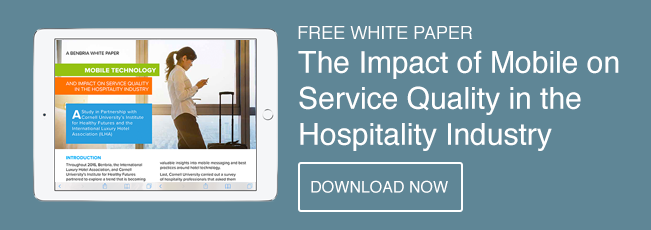In a world teeming with various methods of digital communication, it can be difficult to understand the difference between messaging and texting. This confusion is understandable. They serve the same purpose — that is, the instant transmission of a message to a recipient — but the two channels are distinct from each other as well.
You may be wondering which to choose to best connect with your hotel guests and enhance their experience. We’ve laid out the differences between the two so you can fully understand before you make your choice.
Instant Messaging
There are many popular messaging apps on the market today. You’ve likely heard of some of them: Facebook Messenger, Whatsapp, Line, Snapchat, and Skype, to name just a few. These kinds of apps are popular with younger Millennials and Generation Z in particular — almost half of smart phone owners aged 18 to 29 use at least one messaging app.
Because of this, instant messaging might seem like an appealing method of connecting with guests. Here’s what you need to know:
- App download required. Almost without exception, instant messaging apps must be downloaded onto the user’s phone or desktop before they can be used. This isn’t always ideal, seeing as the average smartphone user spends 80 percent of their time using their top five apps, none of which offer instant messaging: Facebook, YouTube, Pandora, Maps, and Gmail.
- Single platform. For the most part, apps cannot communicate with each other. For example, a Facebook Messenger user cannot send a message to a Snapchat user, and vice versa.
- Connection required. For many messaging apps, users must be connected with each other before they can freely send messages. For brands that want to message with their guests, this means that both the sender and recipient must have the app downloaded.
- Relies on notifications. When a user receives an instant message, the app generally sends a push notification to let them know. However, push notifications can be turned off, meaning there is no guarantee that the user will receive the message in a timely manner, if at all.
Texting
Almost every mobile phone, whether smart or otherwise, has the capability to send and receive text messages. That might be why text messaging is the most frequently used data service in the world; 86 percent of US smartphone owners use it versus the 28 percent who use instant messaging. Ninety-seven (97) percent of smartphone owners text at least once per week, while on average, Millennials send 67 texts every single day. Here are a few reasons texting is more convenient and ubiquitous than instant messaging:
- No app required. Users do not need to download anything to use text messaging on their device. Texting is simply more convenient than instant messaging, as evidenced by the rate of app usage among smartphone users — the majority of them download an average of zero apps per month.
- It’s universal. Anyone with a mobile phone can text anyone else with a mobile phone, provided they have the correct number. There is no need to coordinate apps.
- Wider reach. Text messaging has a 98 percent open rate, which makes it perhaps the most powerful method of digital communication. The recipient is more likely to see a text than they are an instant message, especially if they aren’t logged into the messaging app being used.
- No sign-in necessary. Unlike instant messaging, users do not have to sign in to an app to send or receive messages. It is available on the device at all times, making it very unlikely that the recipient will miss a message.





